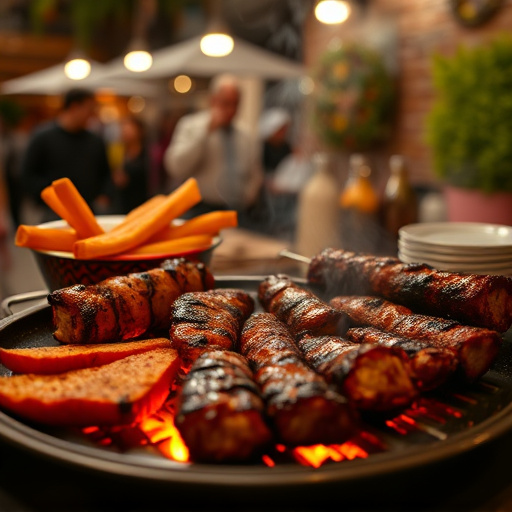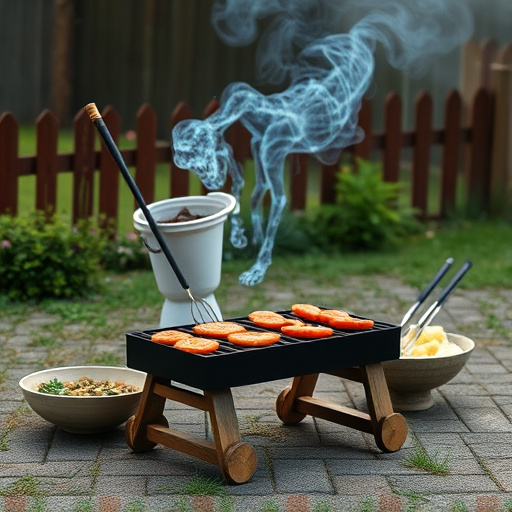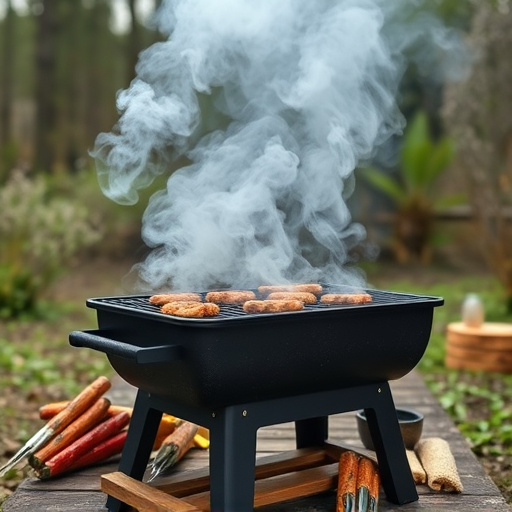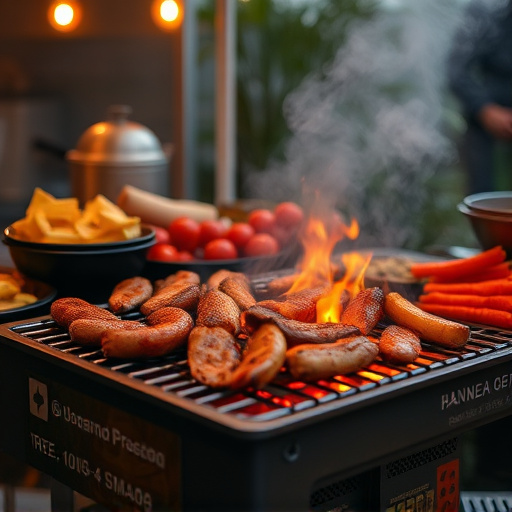Tackle a delicious Easy BBQ Brisket Recipe with these tips: Use a quality smoker and tools, choose a high-quality 10-12 pound packer brisket with a fat cap, season with a dry rub featuring classic spices and unique touches like smoked paprika and mustard seed, maintain a consistent temperature of 225-250°F (107-121°C) for slow cooking, monitor internal temperature to reach the ideal 165°F (74°C) for tender, juicy meat.
“Unleash your inner barbecue master with our effortless guide to cooking perfect brisket, a classic staple for beginners. Discover the secrets behind this tender cut of meat and learn how to transform it into a mouthwatering dish. From understanding the brisket’s unique characteristics to mastering smoking techniques and temperature control, we’ll equip you with the knowledge for an easy BBQ brisket recipe that’s sure to impress. Get ready to delve into the art of slow-cooked perfection.”
- Understanding Brisket: The Cut and Its Tenderness
- Essential Tools and Equipment for Perfect Brisket Cooking
- Choosing the Right Meat: Selecting Your Brisket
- Dry Rub Basics: Spices to Transform Your Brisket
- Smoking Techniques: A Step-by-Step Guide for Beginners
- Mastering the Internal Temperature: How to Check and Adjust for Tender Results
Understanding Brisket: The Cut and Its Tenderness

Brisket, often considered a chef’s cut, is a meaty beast that requires patience and technique to cook to perfection. It’s a cut known for its remarkable tenderness and flavor when prepared correctly. The key lies in understanding its structure; Brisket has a thin layer of fat cap on top, followed by a tough exterior, and an incredibly tender interior. This muscle fiber, when broken down during slow cooking, results in a melt-in-your-mouth experience, especially when prepared using simple techniques like smoking and slow roasting.
For beginners seeking an easy BBQ brisket recipe, the goal is to achieve this delicate balance. Slow cooking allows the tough connective tissues to break down, making it an ideal cut for low-and-slow methods popular in barbecue traditions. With its rich marbling and flavor potential, Brisket promises a rewarding culinary journey, offering a delicious reward for those who take the time to master this art.
Essential Tools and Equipment for Perfect Brisket Cooking

To master the art of brisket cooking, especially for those new to grilling, having the right tools is key. An easy BBQ brisket recipe relies on a few essential pieces of equipment to achieve that tender, delicious result. First, invest in a good quality smoker; this could be a charcoal or gas grill designed specifically for low-and-slow cooking. A reliable meat thermometer is another must-have; it allows you to monitor the internal temperature of the brisket, ensuring it reaches the perfect level of doneness without overcooking.
Additionally, consider getting a good pair of butcher’s shears or a sharp knife for trimming fat, and a set of tongs for handling the meat. A drip pan can also be beneficial to catch the juices, keeping your brisket moist during the long cook. With these essential tools at your disposal, you’ll be well on your way to creating mouthwatering BBQ brisket with minimal effort.
Choosing the Right Meat: Selecting Your Brisket

When it comes to an easy BBQ brisket recipe, choosing the right cut is half the battle won. Opt for a high-quality, well-marbled beef brisket. Look for a piece with good fat cap—about 1/4 inch or more—as this will help keep the meat moist during the slow cooking process. The brisket has two distinct muscles: the leaner “first cut” or “flat,” and the fattier “second cut” or “point.” For beginners, a whole packer brisket, which includes both the flat and point, is the best option as it provides a generous amount of meat for your efforts.
When selecting your brisket, consider its size—it should be big enough to feed your intended crowd but not excessively large that it becomes overwhelming. A 10-to-12-pound packer brisket is a popular choice for many beginners and will result in an ample supply of delicious pulled beef for sandwiches or plates. Ensure the meat is fresh, with no signs of discoloration or off odors, and stored properly to maintain its quality until you’re ready to cook it in your slow smoker or oven.
Dry Rub Basics: Spices to Transform Your Brisket

Dry rubs are a simple yet powerful way to elevate your brisket from ordinary to mouthwatering. These blends of spices provide a depth of flavor that can transform an average cut of meat into a tender, juicy masterpiece. When crafting your own dry rub for an easy BBQ brisket recipe, consider the classic combination of salt, pepper, garlic, and paprika as a foundation. From there, you can add subtle heat with chili powder or cayenne pepper, or go for a sweeter profile with brown sugar and cumin. Smoked paprika adds a smoky aroma that enhances the overall taste, while mustard seed brings a bit of crunch and a unique earthy note. Don’t be afraid to experiment; different spices and their proportions will create distinct profiles, allowing you to personalize your brisket’s flavor profile according to your preferences.
Smoking Techniques: A Step-by-Step Guide for Beginners

Smoking brisket is an art, but it doesn’t have to be a daunting task for beginners. With the right techniques and some patience, you can create a mouthwatering Easy BBQ Brisket Recipe that will impress your family and friends. Here’s a step-by-step guide to get you started:
1. Choose Your Smoking Method: The most common methods are offset smoker or a pellet grill. Offset smokers use indirect heat, which is ideal for brisket as it allows slow, steady cooking without overcooking the exterior. Pellet grills offer precision control with pre-set temperature options, making them user-friendly for beginners.
2. Prepare Your Brisket: Start by removing any packaging and excess fat cap from your brisket. Season generously on all sides with a dry rub of your choice—a simple blend of salt, pepper, garlic powder, and paprika works wonders. This step is key to infusing flavor throughout the meat.
3. Set Up Your Smoker: Preheat your chosen smoker to the desired temperature, typically between 225°F-250°F (107°C-121°C). Place the seasoned brisket inside, fat side up, on a rack or grill grates. Smoke for approximately 1-1.5 hours per pound until the internal temperature reaches around 165°F (74°C).
4. Maintain and Monitor: Smoking is an art of patience. Keep an eye on your smoker’s temperature and adjust as needed. Use a meat thermometer to track the brisket’s progress, ensuring it doesn’t overcook. Add wood chunks or pellets at regular intervals to maintain smoke and flavor.
Mastering the Internal Temperature: How to Check and Adjust for Tender Results

Mastering the internal temperature is key to cooking a tender and juicy brisket. The ideal target for an easy BBQ brisket recipe is around 165°F (74°C). This might seem lower than expected, but it ensures the meat remains moist and avoids overcooking. Use a reliable meat thermometer inserted into the thickest part of the brisket to check the temperature.
To adjust for tender results, maintain your smoker at a consistent temperature between 225-250°F (107-121°C). If the internal temp surpasses 165°F, remove the brisket briefly from the smoker and wrap it tightly in butcher paper or foil. This step helps insulate the meat, slowing down the cooking process and allowing the interior to reach the perfect tenderness before continuing to smoke.
